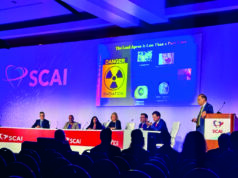
A large single-centre randomised trial has shown that the use of a protective scatter radiation absorbing shield significantly reduces proximal operator radiation exposure for during contemporary cath lab procedures, including coronary and structural interventions.
Results of the ATTENUATE trial—assessing the use of the Radpad Orange (Worldwide Innovations & Technologies) antimony and bismuth drape peripheral shield—were presented during a late-breaking trial session at the 2025 Cardiovascular Research Technologies (CRT) meeting (8–11 March, Washington DC, USA). Investigator Giorgio Medranda (NYU Langone Health, New York, USA) reported that in contemporary cath lab use, Radpad reduced exposure by 50.7% when compared to procedures that did not use the shield system.
Repeated and prolonged ionising radiation exposure to operators in the cath lab, even at low levels, can lead to an increased risk of radiation-induced injury and chronic health problems such as cancer and cardiovascular diseases, Medranda told CRT delegates. As a result, he said, there is an increasing interest in establishing a culture of radiation safety in the cath lab, with evidence needed to show which practices are effective in reducing operator exposure.
Small studies have demonstrated the potential of Radpad to reduce relative operator radiation exposure by anywhere between 20–62%, but Medranda and colleagues at NYU Langone Health wanted to examine the impact of Radpad in the setting of a randomised trial in a contemporary cath lab which performs a wide range of procedures including structural interventions.
Looking at 500 procedures in each arm, including a mixture of structural, coronary and diagnostic procedures, investigators assessed dose-area product (DAP)-normalised operator dose as the trial’s primary endpoint, as well as looking at operate dose, fluoroscopy time and dose area product as secondary endpoints.
The study showed that the primary endpoint, DAP-normalised operator dose stood at 3.1uSv/mGycm^2 for procedures that used Radpad, compared to 6.3uSv/mGycm^2 among procedures that did not use Radpad. Operator exposure stood at 9uSv for procedures using Radpad, and 14uSV for procedures without.
Medranda commented that the study is the largest randomised controlled trial of the Radpad protection drape demonstrated a significant reduction in exposure to the most proximal operator during contemporary cath lab procedures across a wide range of cases, confirming the utility of the technology in contemporary practice.










